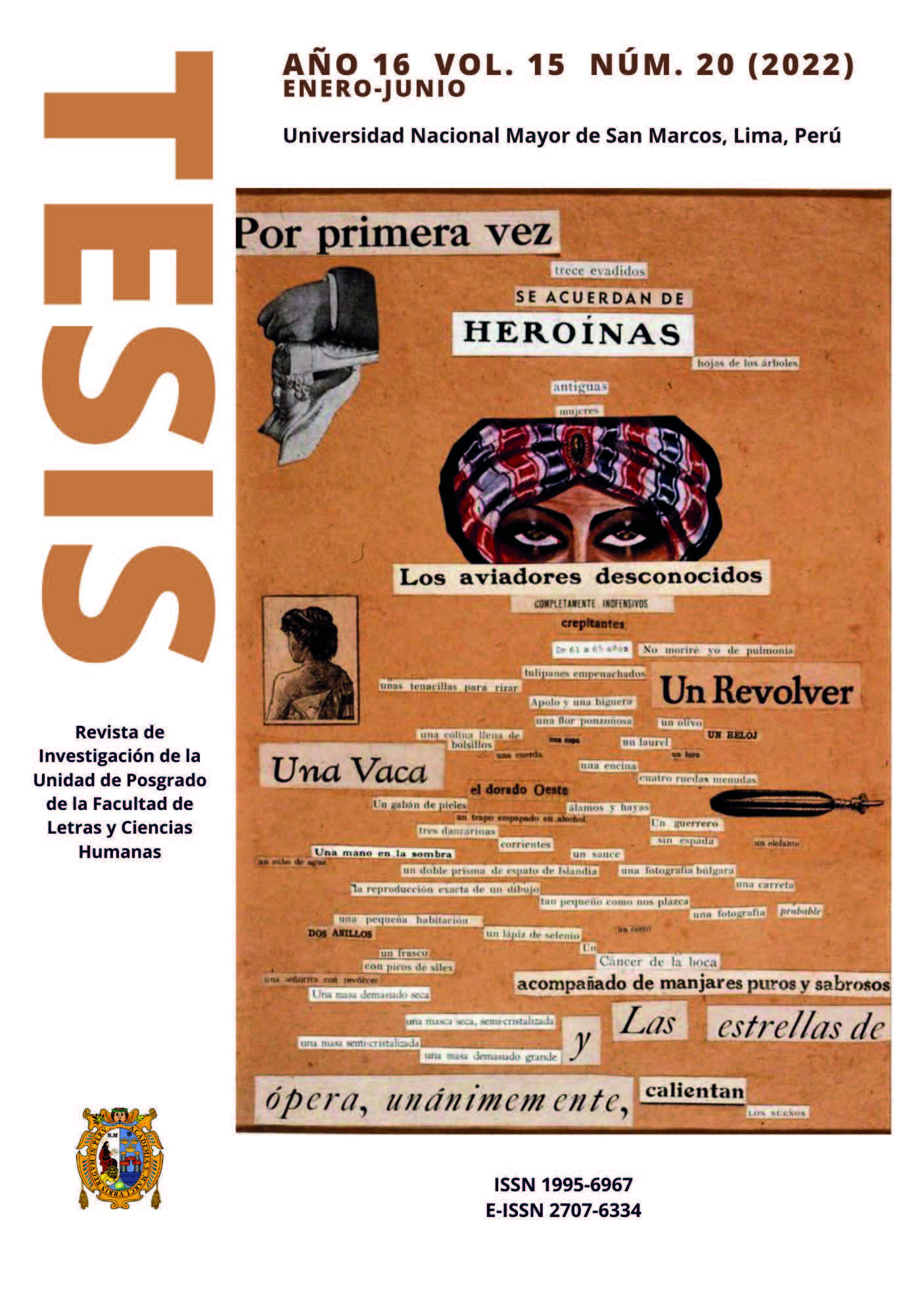“They won’t hear me scream here”: Violence and horror in recent Latin American narrative written by women
DOI:
https://doi.org/10.15381/tesis.v15i20.23522Keywords:
horror, terror, violence, gender, narrativeAbstract
A wide variety of contemporary Latin American female writers have chosen to narrate violence using gothic horror and its devices in recent years. These are not necessarily narratives that respond to the most stable forms of the terror or horror genre. These are fictions that uses their procedures to bring the monstrous to the fore, the reification of the female and dissident body, subordination and feminicide, in order to postulate that not only the “maintenance of patriarchy is a matter of State”, but which is also “preserving the lethal capacity of men and guaranteeing that the violence they commit remains unpunished” (Segato). In many of these fictions, it is not only a matter of discovering how monsters are built, but also of detecting them in different positions of power: as resistance or as sovereigns.
Gothic, in this corpus, goes through terror and violence in its domestic, family forms, through sexual abuse, the persecution of sexual dissidence, child abuse, pedophilia. The demonic appears in patriarchal structures and disseminated in the brutal practices of rites, sects, gangs. The representation of social exclusion, in which the victims of this relentless implementation of neoliberalism are the protagonists, occupies the whole narrations, as well as the foregrounding of sexual taboos overshadowed by hypocritical morality and the denounce of ecocide. The narratives of Mariana Enríquez, Agustina Bazterrica, Dolores Reyes, Fernanda Melchor, Mónica Ojeda, María Fernanda Ampuero and Yeniva Fernández will be the main focus of this article.
References
Ampuero, M. (2018). Pelea de gallos. Páginas de Espuma.
Ampuero, M. (2021). Sacrificios humanos. Páginas de Espuma.
Arandojo, D. (2018). Slender Man. Realidad y ficción de los creepypasta. Editorial Guante Blanco.
Ayén, X. (20 de septiembre de 2021). El nuevo boom de las narradoras latinoamericanas. [Video]. https://youtu.be/neXP3X7RrYw
Bazterrica, A. (2017). Cadáver exquisito. Planeta.
Bianchi, P. (2018). Dermis, huellas de una herida que cincela los huesos. Enríquez, Stigger y Nettel. Revell, 3(20), 163-187 https://periodicosonline.uems.br/index.php/REV/article/view/3178/pdf
Butler, J. (2006). Vida precaria. El poder del duelo y la violencia. Buenos Aires.
Carroll, N. (2005). Filosofía del terror o paradojas del corazón. Antonio Machado Libros.
Cavarero, A. (2009). Horrorismo. Nombrando la violencia contemporánea. Anthropos Editorial, Universidad Autónoma Metropolitana Unidad Iztapalapa.
Enríquez, M. (2019). Nuestra parte de noche. Anagrama.
Esposito, R. (2006). Bíos. Biopolítica y filosofía. Amorrortu.
Federici, S. (2010). Calibán y la bruja. Mujeres, cuerpo y acumulación originaria. [1.ª ed.]. Tinta Limón.
Fernández Gonzalo, J. (2011). Filosofía zombi. Anagrama.
Fernández, Y. (2015). Siete paseos por la niebla. Campo Letrado Editores.
Ferro, G. (2011). Lo que te da terror. En La aguja tras la máscara. Costurera Carpintero.
Gasparini, S. (2020). Las horas nocturnas. Diez lecturas sobre terror, fantástico y ciencia. Argus-a.
Gelder, K. (Comp.). (2002). The horror reader. Routledge.
Gorriti, J. M. (2001). Ficciones patrias. Clarín.
Hayes, I. y Zenobi, M. (11 de marzo de 2021). Una película de terror: Sayak Valencia, teórica feminista. Revista Mu, 157. https://lavaca.org/ni-una-mas/una-pelicula-de-terror-sayak-valencia-teorica-feminista/
Hogle, J. (Comp.). (2002). The Cambridge Companion to gothic fiction. Cambridge University Press.
Honores, E. (2014). La civilización del horror. El relato de terror en el Perú. Editorial Agalma.
King, S. (2006). Danza macabra. Valdemar.
Leffler, Y. (2000). Horror as pleasure: The aesthetics of horror fiction. Almqvist & Wiksell International.
Ligotti, T. (2010). La conspiración contra la especie humana. Un artificio de horror. Valdemar.
Melchor, F. (2017). Temporada de huracanes. Penguin Random House.
Moraña, M. (2017). El monstruo como máquina de guerra. Iberoamericana Vervuert.
Morgan, J. (2002). The biology of horror: Gothic literature and film. Southern Illinois University Press.
Mulvey-Roberts, M. (Comp.). (1998). The Handbook to Gothic Literature. New York University Press.
Ojeda, M. (2020). Las voladoras. Páginas de Espuma.
Ojeda, M. (2018). Mandíbula. Editorial Candaya.
Paglia, C. (2020). Sexual personae. Arte y decadencia desde Nefertiti a Emily Dickinson. [1.ª ed. en español]. Deusto.
Reyes, D. (2019). Cometierra. Editorial Sigilo.
Rivera Garza, C. (2021). El invencible verano de Liliana. Penguin Random House.
Scherer, F. (12 de junio de 2021). El nuevo boom latinoamericano: las escritoras marcan el rumbo. Lifestyle.
Segato, R. (2018). Femigenocidio como crimen en el fuero internacional de los Derechos Humanos. En La guerra contra las mujeres. Prometeo libros.
Torres y Quiroga, R. (2019). Obras completas. Raimunda Torres y Quiroga. Tomo I. Ediciones Ciccus.
Valencia, S. (2010). Capitalismo gore. Melusina.
Vedda, M. (2021). Cazadores de ocasos. La literatura de horror en los tiempos del neoliberalismo. Editorial Las Cuarenta y El Río sin Orillas.
Downloads
Published
Issue
Section
License
Copyright (c) 2022 Sandra Gasparini

This work is licensed under a Creative Commons Attribution 4.0 International License.
THE AUTHORS RETAIN THEIR RIGHTS:
(a) The authors retain their trademark and patent rights, and also on any process or procedure described in the article.
(b) The authors retain the right to share, copy, distribute, execute and publicly communicate the article published in Tesis (Lima) (in example, depositing the article in an institutional repository or publish it in a book), with recognition of its initial publication in the Tesis (Lima).
(c) The authors retain the right to make a later publication of their work, to use the article or any part of it (for example: a compilation of their works, notes for conferences, thesis, or for a book), provided that they indicate the source of publication (authors of the work, magazine, volume, number and date).














